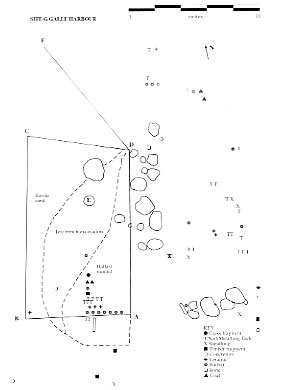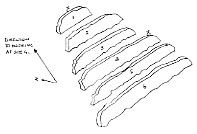 |
|
Maritime
Lanka |
6 Jan 2002
|
|||
| Last modified: 6 Jan 2002 |
 "Site
G" is the site of a wooden wreck on the eastern side of the bay, characterised
by a mound of ballast stones and a few small scattered artefacts. After earlier
surveys in 1992 and 1993, it was decided to continue the survey of Site G in
1997, as it might be affected by construction work for the proposed new container
terminal, and the work done on the site must be seen as a form of rescue archaeology.
There were also other reasons to start new research at Site G. Archival research
suggested that it could be the wreck of the VOC ship Geinwens,
and in 1995 the Sri Lanka Sub Aqua Club had found ships' timbers exposed to
the south of the site.
"Site
G" is the site of a wooden wreck on the eastern side of the bay, characterised
by a mound of ballast stones and a few small scattered artefacts. After earlier
surveys in 1992 and 1993, it was decided to continue the survey of Site G in
1997, as it might be affected by construction work for the proposed new container
terminal, and the work done on the site must be seen as a form of rescue archaeology.
There were also other reasons to start new research at Site G. Archival research
suggested that it could be the wreck of the VOC ship Geinwens,
and in 1995 the Sri Lanka Sub Aqua Club had found ships' timbers exposed to
the south of the site.
The orientation is NE-SW, perpendicular to a granite rock face. The wreck lies on a calcareous sand seabed, with a gentle slope, interspersed with large granite boulders concentrated at the base of the rock face. The wreck site is characterised by the ballast mound and other smaller artefacts scattered amongst the stones. Changes noted at this site between 1993 and 1997 may be explained by the unexpected swell and consequent surge experienced during the later expedition. Previously understood to be the calmer side of the Bay of Galle, the surge had produced a series of parallel sand waves alongside and encroaching on the ballast stones of the wreck site. Coarse sand and shell grit overlies finer sediments. Despite a thorough investigation of the ballast only one piece of ships’ timber was located. As with previously discovered timber on this site, it was very degraded, soft and friable. Samples of the timber were not taken, as wood identification and water content of samples collected in 1993 had been previously analysed [Green & Devendra (eds) 1993]. The selection of artefacts recovered consists of ships fastenings, sheathing, pottery and coal. All but a few of these were found exposed amongst the larger boulders which lie between the ballast and the base of the cliff.
It was decided to concentrate the survey and excavation on three areas:
A new baseline was established running SW-NE. From the area where in 1993 an exploratory excavation was conducted to the east and the south, an excavation square of about 10 by 10 metres was established. A modern concrete mooring is in the centre of the square. The exposed ballast stones in the east extend to the west to a seabed of sand waves. Here was the best chance of finding surviving timber.
On two occasions the baseline was accidentally disturbed and the grid had to be re-positioned. The final baseline (A-D) measured 14.40 metres in length at an angle of 10° east of north, extending a further 11.70 metres (D-F) on a bearing of 332°.
In the first three weeks of the expedition, no water dredge or other excavation tools were available. By hand fanning and the removal of ballast stones within the gridded area, several ship’s fastenings and samples of coal, glass, and ceramics were found and one balk of timber was revealed.
In several dives, a shallow area east of the baseline was surveyed over a distance of about 50 metres to the base of the cliff face. Between the boulders, fragments of copper sheeting, ships’ nails, coal and concretions were found. North of the site, a large piece of iron concretion was found, but it is uncertain whether this can be related to the site.
 In
1995 a small team from the Sri Lanka Sub-Aqua Club discovered six beams covered
with concretion, and planks underneath. They were all heavily waterlogged and
subject to attack by wood borers. The beams were 2-3 inches thick, 10 inches
high, and 8 inches apart; they varied in length from 2.5 to 7 feet.
In
1995 a small team from the Sri Lanka Sub-Aqua Club discovered six beams covered
with concretion, and planks underneath. They were all heavily waterlogged and
subject to attack by wood borers. The beams were 2-3 inches thick, 10 inches
high, and 8 inches apart; they varied in length from 2.5 to 7 feet.
During the October 1997 expedition, the area south of the site was systematically surveyed. Along the edge of the boulder outcrop, a section of timber, 1.25 metres in length was found; this timber can be related to the site through the nail hole which corresponds to the nails found on the site. The timbers discovered in 1995, however, were not relocated in 1997. (The original finders made fresh attempts to relocate them in April 1999, and concluded that they may have been covered again by sand.)
For hypotheses and conclusions, see Site G: Dutch or French? For details of how information may be gleaned even from rocks, see the geological-petrological report on a ballast rock.
| Maritime Lanka homepage | Galle index |